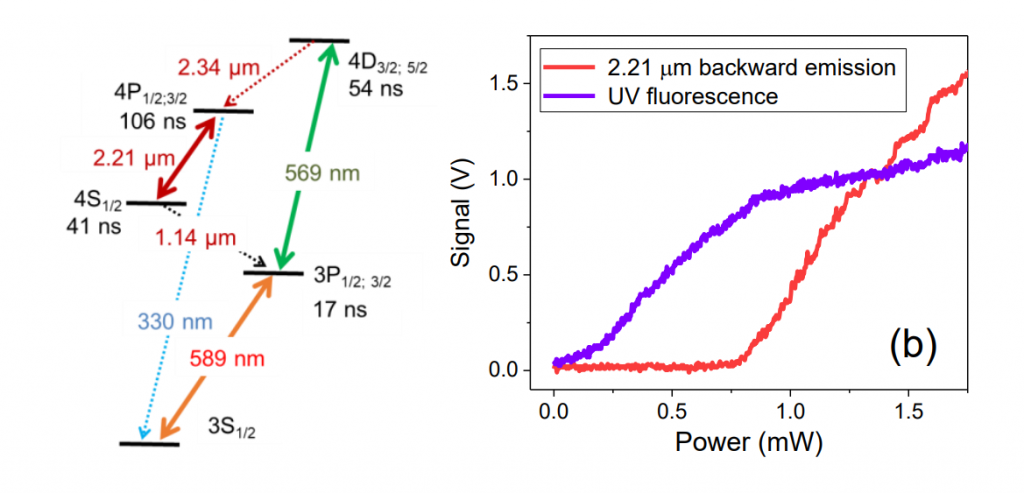In contrast to a common “conventional wisdom” not all lasers have two or more mirrors that make up a laser resonator (a.k.a. laser cavity). In fact, if the gain in the active medium is sufficiently high, only one mirror or even no mirrors at all are required for lasing to occur. The latter case corresponds to a mirrorless laser first demonstrated in 1961 [1] in cesium vapor pumped with a helium lamp.
Our initial motivation to explore such phenomena came from conducting remote sensing of sodium atoms in the mesosphere [2]. In collaboration with our colleagues from the European Southern Observatory, we shoot a laser beam at the sky. Beside creating an artificial star for astronomical observations (a laser guide star), we use the information carried back from the sodium atoms in the atmosphere by the fluorescent photons to infer the magnetic field at the location of the atoms (some 90 km above the surface) and to learn about the rate with which different atoms collide in the mesosphere.
A major shortcoming of the sodium guide stars is that only a tiny fraction of the light emitted by the laser-excited sodium atoms reaches the ground-based telescope we use for detection because the light is emitted in all directions. A dream-case scenario is that we “compel” the mesospheric atoms to shine the light back to us in the form of a directed (laser) beam. In fact, the scenario is realized in our laboratory, among others, with various alkali atoms (Na, Rb, Cs) contained in vapour cells. The conditions are very different from those in the mesosphere, but the hope is that once we understand the physics of mirrorless lasing well enough, we may be able to play similar tricks with the actual laser guide stars.
We look at sodium in the laboratory on the ground, and shine lasers on it, thus pumping the electrons in the sodium to higher energy levels. The electrons then go to lower levels, and as a result of one of these transitions (from an energy level called 4P_{1/2, 3/2} to the level 4S_{1/2} as in the diagram below), we observe laser light (at the wavelength 2.21 μm) [3]. As in any laser, we observe a lasing threshold – a certain power of the pumping laser after which the signal (a light with a wavelength of 2.21 μm in our case) is orders of magnitude greater.

Figures from [3]: Left: sodium energy levels diagram. The electrons are excited from the ground level by 589 nm and 569 nm. On their way back to the ground level, a lasing light is emitted at 2.21 μm. Right: when the power of the pumping-laser is about 0.6 mW the amount of 2.21 μm emission (in red) rises steeply. Fluorescence (in blue) from sodium, a light with a wavelength of 330 nm, indicates the total number of excited atoms.
In the figure above we read that the 2.21 μm emission is described as “backwards”. That is because we detect this light in the direction opposite to the propagation direction of the pump laser light, similar to what we would like to happen with the actual guide star.
We have also realized mirrorless lasing with rubidium [4,5,6]. In one project, we work with our collaborators in Armenia to detect a peculiar kind of mirrorless lasing where the lasing occurs at the same wavelength as the pump light (degenerate mirrorless lasing) [7], at 780 nm, but with polarization orthogonal to that of the pump.
Most recently, we observed multicolored mirrorless lasing in cesium vapor [8]. Rather unexpectedly, this study came out of an analysis of possible systematic effects in our recent search for a particular dark-matter candidate, a bosonic scalar field oscillating at its Compton frequency of up to about 100 MHz [9].
References:
[1] S. Jacobs, G. Gould, and P. Rabinowitz, Phys. Rev. Lett. 7, 415 (1961).
[2] F. P. Bustos, D. B. Calia, D. Budker, M. Centrone, J. Hellemeier, P. Hickson, R. Holzlöhner, and S. Rochester, Nature Communications 9, 3981 (2018).
[3] Continuous-wave mirrorless lasing at 2.21 μm in sodium vapors, A. M. Akulshin, F. P. Bustos, and D.Budker, arXiv:1808.10629 (2018).
[4] Alexander M. Akulshin, Nafia Rahaman, Sergey A. Suslov, and Russell J. McLean, JOSA B 34, 2478 (2017). arXiv:1701.00232 (2017).
[5] Alexander M. Akulshin, D Budker, R. J. McLean, JOSA B 34, 1016 (2017).
[6] Alexander M. Akulshin, D Budker, R. J. McLean, Opt. Lett. 39, 845 (2014).
[7] Evidence for degenerate mirrorless lasing in alkali metal vapor: forward beam magneto-optical experiment, A. Papoyan, S. Shmavonyan, A. Khanbekyan, H. Azizbekyan, M. Movsisyan, G. Bao, D. Kanta, A. Wickenbrock, and Dmitry Budker, arXiv:1811.02326 (2018).
[8] Polychromatic, continuous-wave mirrorless lasing from monochromatic pumping of cesium vapor, D. Antypas, O. Tretiak, D. Budker, and A. Akulshin, arXiv:1905.06997 (2019).
[9] A search for light scalar dark matter in the radio-frequency band with atomic spectroscopy, D. Antypas, O. Tretiak, A. Garcon, R. Ozeri, G. Perez, and D. Budker, arXiv:1905.02968 (2019).
